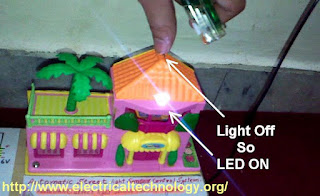Automatic Street Light Control System.(Sensor using LDR & Transistor BC 547.) Very Simple.
Briefing:
Her is our new simple Electrical/Electronics project about Automatic
Street Light Control System.
- it is a simple and powerful concept, which uses transistor (BC 547 NPN) as a switch to switch ON and OFF the street light system automatically.
- It automatically switches ON lights when the sunlight goes below the visible region of our eyes. (e.g in evening after Sunset).
- it automatically switches OFF lights when Sunlight fall on it ( i.e on LDR ) e.g in morning, by using a sensor called LDR (Light Dependent Resistor) which senses the light just like our eyes.
- By using this Automatic system for street light controlling, we can reduce energy consumption because the manually operated street lights are not switched off properly even the sunlight comes and also not switched on earlier before sunset.
- In sunny and rainy days, ON and OFF time differ noticeably which is one of the major disadvantage of using timer circuits or manual operation for switching the street light system.
Requirements
- LDR Light Dependent Resistor
- Take 2 transistors. (NPN transistor- BC547 or BC147 or BC548)
- Resistor- 1K, 330Ohm, 470 ohm
- Light emitting diode (LED) - Any color
- Connecting wires- Use single-core plastic-coated wire of 0.6mm diameter (the standard size)-You can use wire that is used for Computer Networking.
- Power supply-6V or 9V
Procedure
- Insert first transistor Q1-BC547 (NPN) on breadboard (or general PCB) as shown in the circuit diagram 1.
- Connect another transistor Q2- BC547 (NPN) on breadboard as in step 1.
- Connect wires across emitter pin of both transistors and –ve terminal of battery (lowest/ bottom row of breadboard.)
- Connect a wire across Collector pin of transistor Q1 and Base pin of transistor Q2.
- Connect a resistor 1K across positive terminal of battery (topmost row of breadboard) and Collector pin of transistor Q1.
- Connect Light Dependent Resistor (LDR) across positive terminal of battery (topmost row of breadboard) and base terminal of transistor Q1.
- insert a resistor- 330 Ohm across base pin of transistor Q1 and negative terminal of battery (lowest bottom row of breadboard).
- Connect a resistor 330R across positive terminal of battery (topmost row of breadboard) and anode terminal of LED (Light emitting diode) & Connect the cathode terminal of LED to Collector pin of transistor Q2.
The simple circuit is ready for testing now.
Connect 6V battery terminals to the circuit as show in fig and see the output. As you block light falling on Light dependent resistor
(LDR), the LED glows.
LED
GLOWS EVEN IN LESS DARKNESS. Use torch light or Lighter if the LED glows in less darkness.
in addition, you can try to adjust the sensitivity of this circuit by using a variable resistor in
place of R1-300Ohm. Try this circuit with other resistances as well, (e.g, 1KΩ, 10KΩ and 100KΩ, etc)
Circuit Diagram 1.Automatic Street Light Control System.(Sensor using LDR & Transistor BC 547.) Very Simple. We have tried this one in this tutorial bu you can also try the second one
Circuit Diagram 2 .Automatic Street Light Control System.(Sensor using LDR & Transistor BC 547.) Very Simple.
As Light is falling on LDR ( Light Dependent resistor) So LED does not glow. ( LED = Off)
You can see now that we have blocked light falling on Light dependent resistor (LDR), so the LED glows ( LED = ON)











No comments:
Post a Comment
its cool